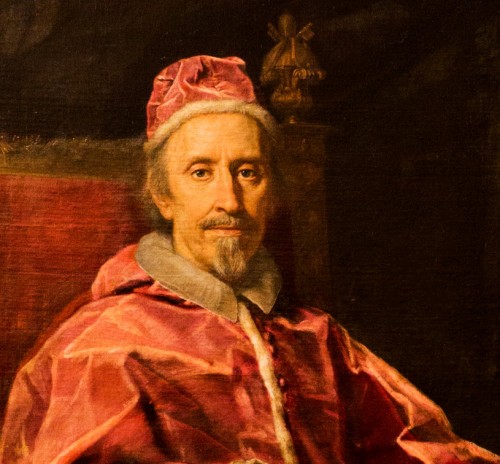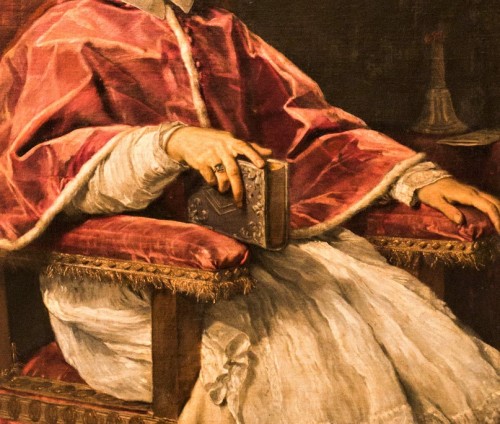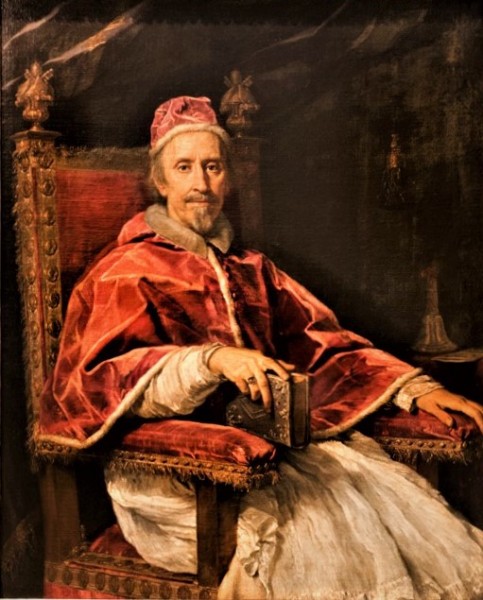
Portrait of Pope Clement IX, Carlo Maratti, fragment, Pinacoteka Vaticana - Musei Vaticani

Carlo Maratti, Portrait of Pope Clement IX, Pinacoteka Vaticana - Musei Vaticani

Portrait of Pope Clement IX, fragment, Carlo Maratti, Pinacoteka Vaticana - Musei Vaticani

Carlo Maratti, Portrait of Pope Clement IX, Pinacoteka Vaticana - Musei Vaticani
In undertaking the painting of the pope’s portrait, Carlo Maratti was faced with a difficult challenge. This was because, fifty years prior a truly outstanding image was created in Rome – praised and admired by all, the Portrait of Pope Innocent X by Diego Velázquez. Although, while the Spanish painter was able to “tell” the whole truth about the bitter Pope Innocent X, Maratti was able to capture the oft-praised virtues of Clement IX – gentleness, virtuousness, sensibility, and generosity. However, that was not all – also his weakness and tiredness predicting the approaching death. Looking on at his visage, we can still today imagine an ideal pope – full of mercy and wisdom.
In undertaking the painting of the pope’s portrait, Carlo Maratti was faced with a difficult challenge. This was because, fifty years prior a truly outstanding image was created in Rome – praised and admired by all, the Portrait of Pope Innocent X by Diego Velázquez. Although, while the Spanish painter was able to “tell” the whole truth about the bitter Pope Innocent X, Maratti was able to capture the oft-praised virtues of Clement IX – gentleness, virtuousness, sensibility, and generosity. However, that was not all – also his weakness and tiredness predicting the approaching death. Looking on at his visage, we can still today imagine an ideal pope – full of mercy and wisdom.
According to a then biographer and a friend of the painter, Giovanni Pietro Bellori, Pope Clement IX from the Rospigliosi family was portrayed during a carnival, when he was wont to leave the city center teeming with life and joy and go to Aventine Hill to a Dominican monastery at the Church of Santa Sabina. The sixty-nine-year-old pope had already been ill at that time and died several months later. Reportedly despite his already visible weakness, he did not complain about having to pose for a long time and even praised the artist for the pleasant time they had spent together. However, when during one of the sessions the pope fainted, the painter gave up on long meetings. He concentrated on capturing the face of the model, all the rest he created in his workshop. Bellori also underlines the fact that during his work, the 25 years younger artist was able to sit, which was something truly exceptional as generally during the presence of the Holy Father everybody stood. We can even experience this – looking at the pope we sense that we are on equal footing with him, which makes this work different from the one completed by Velázquez. However, the main difference is the way of treating the painting matter. Where Velázquez allows himself for some offhandedness – rapid, sweeping strokes of the brush, Maratti devotes time to detail. He delicately guides his brush and with attention highlights the refraction of light on the pope’s mozzetta lined with sable fur. He also chooses a lighter tone of carmine red for the robes and the cap (camauro). It blends in with the very same color of the padding of the pope’s armchair. The entire composition is placed on a background of an enormous, suspended portiere, held up by tassels hanging down at the level of the pope's face. On a table at the right, we notice a bell and a piece of paper – this is where the painter left his signature, dedicating his work to “Alla Santità di Nostro Signore Clemente IX per Carlo Maratti, 1669” – to His Holiness, Clement IX.
Everything in this portrait is impeccable – the calm, full of virtue visage of the pope and his hand gestures – one resting on a book which he seems to be reading, the other, delicately leaning on the arm of the chair. His tired eyes and seriousness grant him added distinction, but at the same time are a source of our affection towards him, which was not often the case when we think of papal images, which were mainly tasked with emphasizing the representation and majesty of the model. There was no better person than Maratti to portray a man, who not only exhibited literary talents and a love for music but preached compassion to all. And he not only preached it but also practiced it, which was testified to by the grief Romans exhibited after his death. The pope's tomb was treated as a burial site of a saint, so much so that it was feared the body would be stolen. Can there be a better proof of the grandeur of the pope's majesty?
Portrait of Clement IX, Carlo Maratti, 1669, oil on canvas, 145 x 116 cm, Pinacoteca Vaticana (Musei Vaticani)
















